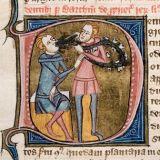RICHARD’S TEETH
 Some of you may have seen a – rather disappointing – article in The (British) Telegraph recently about research into Richard’s teeth.
Some of you may have seen a – rather disappointing – article in The (British) Telegraph recently about research into Richard’s teeth.
The author, Richard Gray, starts with the fanciful description that Richard was killed by blows which were so heavy that they “drove the king’s crown into his head”. However, Bob Woosnam-Savage explained at the conference in Leicester that Richard could only have suffered the injuries that killed him after his helmet had been removed and also explained by what kind of weapon.
Mr Gray then states that Richard suffered from bruxism or teeth grinding. For him, this confirms Shakespeare’s portrayal of Richard as “anxious and fearful” and that the reason might be that “he was wracked with guilt over the fate of the Princes in the Tower, who he is accused of murdering to assume the throne”.
Richard Gray based his article on research by Dr Amit Rai, a London dentist, which was published in the British Dental Journal. It is hardly surprising that Shakespearean flights of fancy are lacking in the original article.
Dr Rai starts with some general information on dentistry in the middle ages. Dental treatment would have been carried out by skilled barbers or surgeons, though monks were the dentists of the time, but they were not allowed to shed blood.
A professor of medicine and surgery at Bologna earlier in the 15th century, Giovanni de Arcoli, published guidelines of how to look after your teeth, some of which are still familiar to us, for instance that you should clean your teeth after eating, should avoid sweets or not break hard things with your teeth. To clean your teeth you should use a thin piece of wood “somewhat broad at the ends, but not sharp-pointed or edged”. Brushes with bristles were only introduced to Europe from China after Richard’s lifetime.
Then Dr Rai looks in more details at Richard’s teeth. He does find indeed tooth surface loss, which might be the result of stress related bruxism, but thinks it is more likely that it was caused by dietary abrasions and erosion. He explains that this erosion is not severe, which indicates a more affluent member of medieval society, who would have eaten food made from more finely milled flour. This is also confirmed by the findings that the individual had eaten a diet rich in seafood – again something that would be expected of someone of a higher social status.
Three teeth were missing, which Dr Rai attributes to caries. There are signs that the gaps where these teeth would have been have closed, indicating that they had been removed by a barber or surgeon earlier in Richard’s life. For Mr Gray this was the result of a diet “rich in carbohydrates and sugar”. Dr Rai, who had just explained that the teeth indicate a protein-rich diet, only mentions that caries would have been more likely in more affluent persons.
Some teeth show mineralised deposits, which probably are a build up of tartar. As there is less of this on certain teeth than on others, it might indicate that Richard followed Giovanni de Arcoli’s guidelines on cleaning teeth, with a piece of wood, not a brush.
The left central incisor was also missing, which Dr Rai thinks could have been knocked out when Richard was killed “by some of the most advanced military weapons of the time” – not his own crown.
On the whole, Richard’s teeth give us a good idea of the dental hygiene people in those time would have used.
The difference between the information published in a daily paper, with its sensationalist interpretations, and that in a peer reviewed scientific journal is striking. There is little doubt, which article is more reliable.
Reference:
Rai, A., ‘Richard III – the final act’, British Dental Journal, Vol.214, No.8 (27 April 2013), pp.415-417
Gray, Richard, ‘King Richard III’s teeth and jaw reveal monarch’s anxious life and violent death’, The Telegraph (1 May 2013). Date accessed: 2 May 2013
Tags: Leicester Greyfriars Dig, Media, Medieval Life, Richard III

2 comments so far
Leave a reply